We have evolved to stand upright. Studies show we spend too much time sitting and at least two hours a day should be standing during working hours for people in sedentary occupations. The downside of sedentary occupations can be increased mortality from a range of causes including cardiovascular problems, obesity and diabetes.
Standing Requires Balance
Standing is clearly important to our physical health. But we don’t want to fall over either. We spend a lot of time on our feet. Lack of balance - physical steadiness - leads to increasing risk of falls with age.
About one in three people over 65 will have a fall over the next year. According to NeuRA (Neuroscience Research Australia), falls and fall-related injuries are one of the most common causes of ill health and morbidity in older adults and lead to functional impairment, disability, lower quality of life, and fractures. The cost to the Australian economy is greater than any other injury including car crashes.
The solution lies in balance training, one of the four basic exercise requirements along with flexibility, strength and stamina. A balance between these four elements is typically part of a traditional pilates participation program, often provided by progressive physiotherapy practices.
The aims of balance training are to improve posture, prevent injury and if required, to support rehabilitation. As well as reducing the risk of falls, improved balance can improve the activities of daily living and participation in leisure-time activities. It makes sense to incorporate balance exercises into the physical activity programs of all older adults.
Some basic exercises
One of the challenges with managing balance is to know where to start. It’s a good idea to talk with your GP about this. Neura provides 5 simple exercises that can be done at home as a start to taking more control over your balance. See them later in this article.
Neura has also completed the Australian component of a research program called Standing Tall which encourages older people to engage in a more structured exercise program as part of their framework for healthy ageing. We will let you know when the results are published.
Balance the options for your longevity
Just like managing our physical balance, taking control of our future requires working through different options and deciding on the trade-offs needed to strike the right balance.
The SHAPE Analyser weighs up five important longevity influences. It notes the balance in the remaining stages of your life and provides a suggested time frame for planning your future. The Longevity Plan builds on this to provide you with more control over the rest of your life.
Best Home Exercises to Reduce Your Falls Risk
NeuRA exercise specialist Assoc. Professor Kim Delbaere has put together a short list of exercises that could help you to maintain good balance and reduce your risk of falling. ‘We face a risk of deconditioning if we don’t do these kinds of movements regularly. These exercises strengthen our muscles, joints and ligaments and lessen the likelihood of a fall later’ she said.
These simple movements are easy to do at home and help to prevent the loss of strength and stability. They have a significant benefit for people over the age of 65 years for whom practicing for just two hours per week can significantly reduce the risk of falling.
You can download these exercises here to print them out on one page for easy reference. They are adapted from www.neura.edu.au/researcher-news/best-home-exercises-to-reduce-your-falls-risk/. See www.neura.edu.au for insights into their remarkable brain and nervous system research.
Knee raises - Helps with: climbing stairs, getting in and out of cars, stepping off buses
- Hold on to a bench or chair to maintain your balance
- Lift one knee to hip level, so that your leg is bent at a 90-degree angle
- Hold it there for 5 seconds before you swap to your other knee
- Repeat 8 times, with each knee
Side leg raises - Helps with: side-stepping and reduces your likelihood of tripping
- Hold on to a bench or chair to maintain your balance
- Put your weight on one leg and lift the other leg to the side, like a pendulum
- Hold it there for 5 seconds before you swap to the other leg
- Repeat 8 times, on each leg
Heel raises - Helps with: walking and climbing stairs
- Hold on to a bench top or something high up and solid
- Lift both of your heels off the floor so that your weight is in the balls of your feet or toes
- Hold this for 3 seconds before placing your heels back on the floor
- Repeat 5 times
Stepping up - Helps with: stability, especially on uneven surfaces
- Find a staircase with a railing you can hold on to
- Focusing on the first stair only, plant your foot on the step and move up on to it
- Then step back down
- Repeat 5 times, stepping up and back down at your own pace
Sit to stand - Helps with: getting up and down from a chair or toilet
- Find a chair and sit in it. Use a table or steady nearby surface to help you push up if needed
- Slowly stand up from the chair, using your arms for balance if needed. To make it more challenging, cross your arms over your chest or hold them out in front of you
- Lower yourself back into the chair, maintaining the same arm position
- Repeat 5 times
